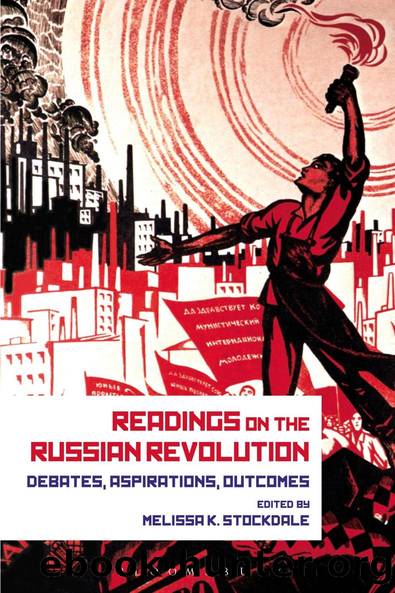Readings on the Russian Revolution by Melissa K. Stockdale

Author:Melissa K. Stockdale [Stockdale, Melissa K.]
Language: eng
Format: epub
ISBN: 9781350037427
Barnesnoble:
Publisher: Bloomsbury Academic
Published: 2020-09-03T00:00:00+00:00
PART THREE
Revolutionary Dreams and Identities
Chapter 9
Bolshevik Ritual Building in the 1920s
Richard Stites
Ritualismâthe use of created forms of symbolic behavior for devotional and celebratory moments in lifeâfound its way into many corners of the Russian Revolution. The emergence of a search for new ritual as part of a Bolshevik religion reveals much about the transition from the revolutionary utopianism of the Civil War period to the revolutionary experimentalism of the 1920s. Many Bolsheviks were seized by the vision of War Communism as a permanent order and an ideal structure. When this vision receded in the early 1920s, some revolutionaries turned to another form of utopia buildingâexperimental life from the bottom up. The years of the New Economic Policy (NEP) were an ideal setting for social and cultural experimentation. On the one hand, the partial restoration of capitalism engendered fierce hostility among committed communists, particularly veterans, workers, and radical intellectuals. Some of these tried to fight, repudiate, or even forget the realities of NEP by creating experimental enclaves of equality, community, and innovative culture or by drastically reordering old institutions. On the other hand, the very atmosphere of peace and normality, of relative tolerance and pluralism, created a sympathetic environment for leisurely culture building on a trial-and-error basis.1
The ritual race for Russian souls was one of these experiments. Its roots can be found in the intellectual current within early Bolshevism known as god building, launched after the Revolution of 1905 by the writer Maxim Gorky and the future commissar of enlightenment Antolii Lunacharskii. Although Lenin, the leader of the Bolshevik Party, fought it angrily, god building recurred in many guises in the first decade after the Revolution of 1917: in the arts, in the debates over communist morality, in the cult of Lenin, in revolutionary festival. Lunacharskii bowed to Leninâs ban on god building as a movement but never abandoned its religious kernel. He envisioned socialism as immediate community and faith triumphant, its basic human attributes as love and solidarity, and its historical agent as the proletariat. This was expressed in his own writings and speeches, in the kind of art he favored, and in the content of the early festivals that he promotedâparticularly the massive theatrical spectacles in Petrograd in 1919-20 that were enveloped in myth, martyrdom, sacrality, and holy joy. But the broad religiosity of the early outdoor festivals (prazdniki) diminished in the 1920s, giving way to a heavy politicization and instrumentalism.2
Bolshevik observers of culture in the early 1920s were alive to the ritual and theatrical elements unfolding in all kinds of arenas. There was often a kind of reductionalism in the rhapsodic appeals of some to turn all of life into theater and all of theater into church. But it became increasingly clear that revolutionary forms and symbols, modes of expression and gatheringâthe festivals of revolutionâdid not in and of themselves provide the basic elements of a new religion: community rites of celebration, dedication, or mourning that evoked emotional forces transcending political and civic needs. But what kind of
Download
This site does not store any files on its server. We only index and link to content provided by other sites. Please contact the content providers to delete copyright contents if any and email us, we'll remove relevant links or contents immediately.
| Archaeology | Essays |
| Historical Geography | Historical Maps |
| Historiography | Reference |
| Study & Teaching |
Underground: A Human History of the Worlds Beneath Our Feet by Will Hunt(12024)
Sapiens by Yuval Noah Harari(5294)
Navigation and Map Reading by K Andrew(5111)
The Sympathizer by Viet Thanh Nguyen(4305)
Barron's AP Biology by Goldberg M.S. Deborah T(4099)
5 Steps to a 5 AP U.S. History, 2010-2011 Edition (5 Steps to a 5 on the Advanced Placement Examinations Series) by Armstrong Stephen(3689)
Three Women by Lisa Taddeo(3354)
Water by Ian Miller(3128)
The Comedians: Drunks, Thieves, Scoundrels, and the History of American Comedy by Nesteroff Kliph(3039)
Drugs Unlimited by Mike Power(2545)
A Short History of Drunkenness by Forsyth Mark(2233)
DarkMarket by Misha Glenny(2159)
The House of Government by Slezkine Yuri(2159)
And the Band Played On by Randy Shilts(2129)
The Library Book by Susan Orlean(2042)
Revived (Cat Patrick) by Cat Patrick(1963)
The Woman Who Smashed Codes by Jason Fagone(1929)
Birth by Tina Cassidy(1864)
The Absolutely True Diary of a Part-Time Indian by Sherman Alexie(1858)
